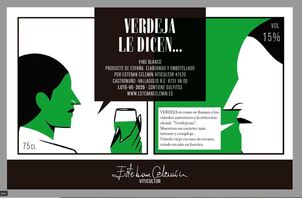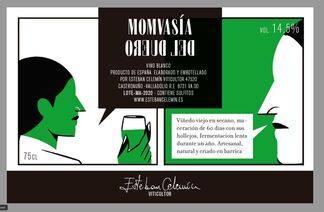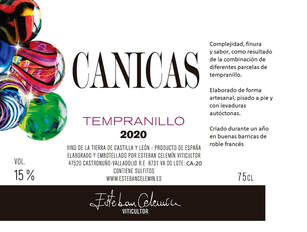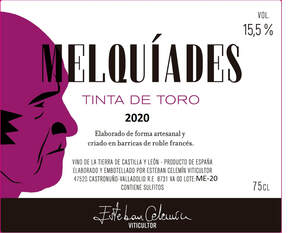Esteban Celemin's wines are the result of a decade-long passion project that was sparked by his belief in the incredible potential of the nearly extinct Albillo Real grape variety. His hometown of Castronuño, located in the Castilla y Leon region on the southern bend of the Duero River, has a rich history of cultivating Albillo Real, in contrast to the surrounding areas where Tempranillo and Verdejo are the preferred varieties in Toro and Rueda. Even though many of the vineyards in the area had been uprooted and replaced in the 70s, Esteban managed to find five very small and old vineyards, which he dedicated himself to saving and revitalizing. the sandy soils in this area are the reason these old grape varieties survived phylloxera and continue to produce grapes today. Esteban has taken cuttings from varying old plants to bring genetic diversity to a small limestone plot where his youngest vines now grow. The 'estate' is a mere 2 hectares, but Esteban also works closely with some trusted friends' vines, all of which he farms organically and with minimal intervention in the cellar. Esteban's goal is to bottle everything separately, independent of the quality, even if a vineyard only produces a single barrel, in order to showcase the unique terroir expressed not only through Albillo Real, but also through other native grapes such as ancient clones of Malvasia and Verdeja, as well as Tinto de Toro. His passion for letting each wine speak for itself with minimal intervention is evident in his annual production of 8-10 different wines, amounting to only about 15,000 bottles.
|
esteban celemin 'señora vale'
100% albillo real The Señora Vale is the youngest vine expression of the incredible and complex Albillo Real grape. Esteban planted the vines in 2014 (in 4 different methods), taking clippings from three very old vineyards of Albillo to combine their historic complexity with the unique chalky limestone soils of the new plot. The vineyard requires a slow harvest each fall, taking a lot of time as the different plants ripen, and are only picked once they show an apricot freshness that Esteban loves in the grape. Then, the grapes are foot crushed and very slowly pressed over many hours. After a month and a half, the natural fermentation finishes in a small steel tank (no stirring), and then goes through full malolactic in small used barrels. This whole process takes about a year until bottling, having wonderful complexity in the finished wine. Bright aromas of tree-ripe apricots, peach skin, blanched almond, and white flowers show through, leading to a gorgeously textured palate that has the glycerol side of juicy stone fruits, an edgy bright minerality, and a long finish that morphs and changes as the wine opens. A stunning white that can age remarkably well, or just drink now. |
esteban celemin 'verdeja le dicen'
100% verdeja The Verdeja le Dicen is a very particular and exciting blend of 4 tiny vineyard plots of the Verdejo grape, however it is a type of Verdejo that pre-dates clonal selection, so it takes the older name ‘Verdeja’. Each plot is only .2 hectares, the youngest of which is 35 years old, and 2 of the vineyards are over 100 years old. The vines are strictly dry farmed, and when hand-harvested, the grapes are foot crushed and then put into a vertical press. The juice settles in a small tank and then goes into 225L French barrels for a very long natural fermentation. With a bit of lees stirring, the complexity of this wine develops over the long fermentations, bouncing around from natural yeast to natural yeast, only adding depth and character to the finished wine. The result is characteristic of Verdeja, versus the commonly found Verdejo, having an aromatic profile driven by fennel, grass, and a muskiness that is not driven by just fruit. In the mouth, the texture is deep, with layers of spicy fruit, fresh greens, and hints of citrus pith, all gathering to a long and unique finish. |
esteban celemin 'momvasía del duero'
100% momvasia The Momvasia del Duero comes from a tiny plot of 150 bush vines or so, over 100 years in age, of the Malvasia grape. This grape used to be found in the area much more than today, as it was ripped out for other grapes, as this white grape in extreme heat leads to a fairly boring finished wine. Esteban however wanted to keep the integrity and history of this grape, and bring it forth with something special, so he decided to let it ferment naturally on the skins for 60 days to add depth and texture to the wine. Having also spent close to a year in a single barrel of French oak, the result is full and developed and quite complex. Aromatics of fresh forest floor, mushrooms, peach pit, and golden apricots, the wine comes onto the palate with wonderful full texture, round fruits, and plenty of sapidity to keep it all tight together. A unique wine of the region to say the least, it is meant to enjoy, contemplate, and have with just about any cuisine. |
|
esteban celemin 'ultimas huellas - cientosiete'
100% albillo real The Ultimas Huellas ‘Cientosiete’ comes from nearly 90-year-old vines that were planted on pure sandy soil, in the far southwestern portion of Toro, at about 800 meters above sea level, only 900 meters from the El Pinar plot of large stones. The vines grow out (not up) over top of the sand in a ‘creeping’ fashion, holding close to the earth to shield under the leaves from the sun. This sand gives this quarter-hectare parcel a very distinct and energetic characteristic to the sapid nature of Albillo Real. After the hand-harvest, the grapes were foot-crushed and vertically pressed to ferment naturally in a twice-used French oak barrel and rested there for a year. The aromas and texture of this parcel show itself with more citrus and bright focus than its counterparts, relying on the energy that comes from the land to create a unique sense of fresh texture and saltiness, but with extraordinary mouthfeel and length. |
esteban celemin 'ultimas huellas - el pinar'
100% albillo real The Ultimas Huellas El Pinar comes from 85-year-old vines that were planted on a remarkable plot of large stones, in the far southwestern portion of Toro, at about 800 meters above sea level, only 900 meters from the Cientosiete plot of pure sand oils. The vines reach vertically, and the grapes grow a thick skin to cope with the extreme heat that the stones create in the vineyard. Yet again a different shade of Albillo Real, this vineyard helps the wine focus on the grape’s exuberance and complexity. After the hand-harvest, foot-trodden grapes fermented naturally in a twice-used French oak barrel, and rested there for a year (yes, a single barrel!) The aromatic nature of this plot shows off stone fruits and wax, leading to a palate that is explosive and full-bodied, rich with fruit, and has remarkable mineral-driven length. |
esteban celemin 'a horquilla'
100% albillo real The A Horquilla comes from a stunning parcel on the west banks of the Duero River that was planted around 1902 in beautiful red sand and clay soils. These old vines create a very precise and beautiful texture in the finished wine, showing off the fineness and saltiness that this low-acid grape needs to shine. The grapes are partially destemmed and foot-trodden once in the cellar and go into a manual vertical press before the juice ferments naturally in once-used French barrique. After aging a year, the wine is bottled and displays yet again another expression of this essential white variety, coming from soils different from its counterparts yet vinified the same. The mouth has vibrant yet restrained flavors, offering a magical texture that sets itself apart and unique. Notes of sesame, salt, wax, and bits of stone fruit lend to a full mouth of luxurious balance, delicate and complete at the same time. |
|
esteban celemin 'canicas'
100% tempranillo The Canicas Tempranillo comes from a small .45-hectare plot of Tempranillo vines, as well as from a barrel or two of Tinta de Toro (ancient Tempranillo) that had very soft tannins and more fruit, which fit the concept of this wine. With strict organic dry farming since 2008, the grapes were hand-harvested and came to the cellar to be foot trodden and then began natural fermentation in small tanks. After a gentle pressing, the wine was moved to 225L used French oak barrels for one year of aging. A very light filtration before bottling, and the finished wine is a delightfully easy-drinking and expressive side to Tempranillo. A very complex nose of blackberries, black cherries, tobacco, cocoa beans, and sandalwood, lead to a scrumptious and velvety mouthfeel that is loaded with fruit and easy tannins. The lovely texture is packed with blueberry compote, earthy mushroom, and soft and tasty oak markers that coat the palate yet unaggressively, for a very enjoyable and easy drinking bold red. |
esteban celemin 'melquiades'
100% tinta de toro The Melquiades Tinta de Toro is from only true Tinta de Toro vines, before clonal selection, and the grape that has adapted to the Toro region and climate for many generations. Esteban has several plots of vines that he elaborates separately in order to preserve each plot’s unique character, and only to blend them if they fit the overall profile he hopes to represent this classic grape. After hand harvest, the grapes (and plots) are fermented naturally in wood, maintaining the structure, the fruit, and the style of each vineyard so that the final blend (after one year of aging) can be made. The result is powerful, yet full of elegance and finesse, showcasing the grape to its fullest. The resulting aromatics are dark and deep, rich with earthy soil, tobacco, oaky spice, and dark brambly fruit. In the mouth, the power is present all the way to the finish, but dances around different fruits, ample acidity, supple tannins, vivid spice, and an overall very pleasant texture and mouthfeel. Perfect for braised meats, grilled meats, and anything meats. |







